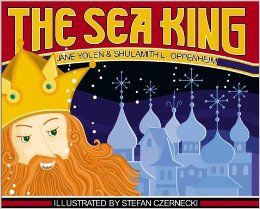 In Russian folklore, the Morskoi Tsar was the king of the sea. His daughters were beautiful maidens known as rusulkas who appeared on the water as swans, geese, ducks, or spoonbills. The sea king lived under the water in crystal halls of great grandeur. He left his palace only to search out a human victim. Having daughters of his own, he especially sought boys or princes — who inevitably carried off or married one of the daughters. — From The Sea King
In Russian folklore, the Morskoi Tsar was the king of the sea. His daughters were beautiful maidens known as rusulkas who appeared on the water as swans, geese, ducks, or spoonbills. The sea king lived under the water in crystal halls of great grandeur. He left his palace only to search out a human victim. Having daughters of his own, he especially sought boys or princes — who inevitably carried off or married one of the daughters. — From The Sea King
This lovely folk tale has many old friends in it: Vasilisa the Wise, a beautiful princess who is also a bird; Baba Yaga the witch in her house that runs by itself on chicken legs; the King of the Sea in his underwater palace of crystal; and the innocently wise boy who finds his way because he’s generous and observant. And it has one of the most poignant story lines of all: the father who promises to sacrifice the first thing he sees when he returns home — only to find out that he’s just been borne a son.
Do we listen to wise princesses? Do we keep our promises, even when it hurts? Do we speak respectfully to ugly old women, even when we don’t know that they’re powerful witches? Can we find our true love, even when our eyes deceive us? Somehow, when we read this tale, we know the answer has to be “yes.”
Jane Yolen and Shulamith Oppenheim have collaborated before on several re-tellings of folk tales. They do good work here. Their storytelling is direct and clear, using simple words to describe the dreamlike creatures and enhance the “charm” aspects of the tale — such as when the hero is asked to do three tasks, each one connected to the others, but each increasingly more difficult. Each time, Vasilisa the Wise tells him, “Go to sleep. The morning is wiser than the evening.”
“The Sea King,” as written by Yolen and Oppenheim, would make a wonderful picture book, one that would entrance a child and draw him or her back with powerful images again and again. Unfortunately, this picture book, designed by Elisa Gutiérrez, and illustrated by Stefan Czernecki, is not wonderful. In the first place, Gutiérrez chose to use the typeface “Insignia,” which is a round, modernistic, san serif font (you can see Insignia here). Am I being just a little too picky, grousing about the font? In the case of a longer story, yes. In the case of a story that wasn’t designed to be approached as a marriage between images and words, yes. But in this case, every word is precious, every turn of phrase counts, and a font like Insignia clashes with the delicate, weirdly beautiful nature of the tale. A king shooting a giant eagle with bow and arrows, an underwater palace with a crystal bridge, and princesses dressed in beaded headresses and white embroidery, waving handkerchiefs, are better served by gracious lettering, something that suggests both tradition and magic.
Stefan Czernecki’s illustrations are an equally poor fit. Czernecki is a good artist. His work is bold, colorful and striking. But its modern, non-realistic style grates against the intricacy of the descriptions here, the images the story evokes .
I think picture books can often suffer from this sort of mismatch between story and illustration. It’s not always clear who the books are for. Are they for very young, pre-literate children? For older children? For adults? Folk tales like The Sea King are timeless, and their readers and listeners can come from any age group. Regardless, this book will be marketed and — in public and school libraries, at least — shelved with other “picture books,” books designated for the youngest children (and Czernecki’s pictures, with their simple details and bold colors, will appeal to very young listeners). Or it will be shelved with other folk tales, and older children, encountering it, will look at the pictures and think, “This is a baby book!”
I read this book aloud to my four-year-old son. He kept wanting to turn the page before I’d finished reading all the words on it. He understood the pictures readily, but there wasn’t enough to them to hold his interest while I read the story. He has delighted in other stories which were just as long, just as complex, in the past. The difference is that those previous stories had pictures with details for him to absorb, and just the right balance between pictures and words on each page that the narrative flow drew him along.
The Sea King is wonderfully told. An adult and someone who loves and reads many, many folk tales will be able to look past the presentation here and see that. I’m afraid children won’t.
(Crocodile Books, 2003)
